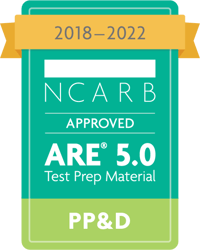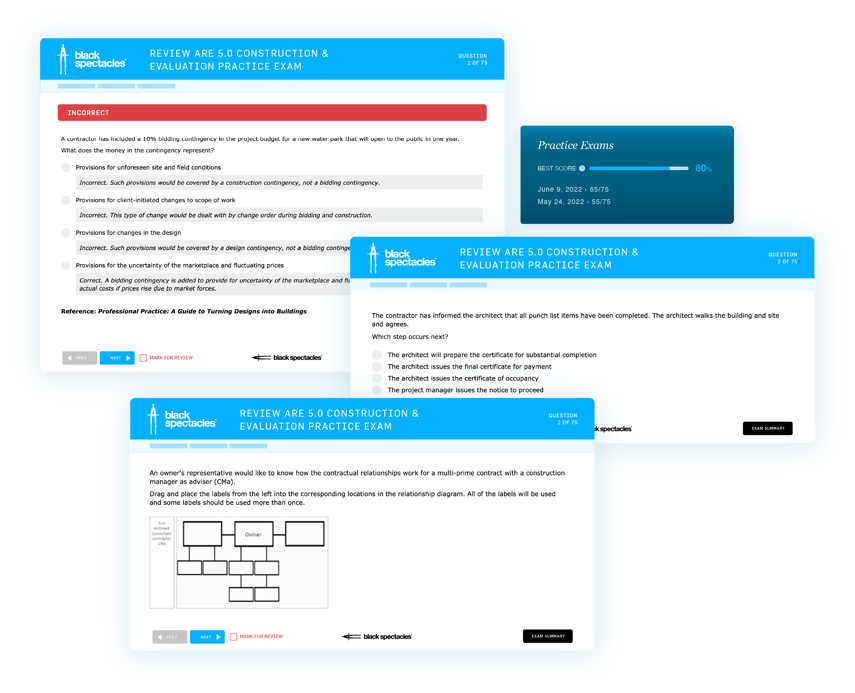Section 1: Environmental Conditions & Context
Building on your findings from the planning and analysis portion of a project, you’ll begin to develop the project by choosing the site and considering environmental aspects. This includes locating the building on the site, considering topography and other factors, as well as incorporating active and passive sustainability practices into the project.
3 content areas for environmental conditions & context:
1. Determine location of building and site improvements based on site analysis
You’ll need to consider the elements—like sun, wind, and light—when orienting your building on a given site. This objective will focus on how to determine a building location based on these factors, as well as adaptive reuse projects to consider and what to do if you run into issues with a chosen site.
2. Determine sustainable principles to apply to design
You'll have a lot of options when it comes to sustainability in your project—so it'll be up to you to determine which ones will actually have an impact on your project. This objective will discuss some of those considerations, and how you can review data and surveys to make your decisions.
3. Determine impact of neighborhood context on the project design
Designing in context is an important concept discussed in architecture schools across the country, and you’ll get to put that into practice in this objective. You’ll learn to consider your project’s surroundings, as well as adjacency to public amenities, in order to further the design of the project.
Section 2: Codes & Regulations
In this section, you'll start to apply the code analysis you performed during the planning and analysis phase of your project. You'll gain a solid understanding of the parts of the International Building Code that apply to this stage of your project, and you'll start to gain the ability to foresee potential code issues that could arise from early design decisions.
3 content areas to prepare for codes & regulations:
1. Apply zoning and environmental regulations to site and building design
In this objective, you'll learn about different zoning codes, why they're important, and how you can apply them to your project. We'll discuss things like using FAR, parking regulations, impact fees, and environmental regulations.
2. Apply building codes to building design
You have to think about codes during a lot of phases of a project, but this is where you really start to dive into codes and think about how they impact your real life building. In this objective, we'll walk through some different codes you have to be thinking about, how they impact your design, and how you can adapt your design to meet different codes.
3. Integrate multiple codes to a project design
There are many codes that apply to projects, and sometimes those codes don’t agree on a particular topic. In this objective, you’ll learn to apply the more stringent code requirement to a situation in order to satisfy the requirements of all authorities having jurisdiction, while still meeting your client’s objectives.
Section 3: Building Systems, Materials, & Assemblies
Building systems, materials, and assemblies are a major part of the project planning and design process. In order to successfully complete a project, the design needs to be coordinated amongst all disciplines. You should be familiar with MEP and structural engineering, acoustic and lighting design, A/V, security, and fire suppression. Careful consideration should also be given to the materials and assemblies selected for the project to ensure that they are energy efficient, safe, and meet the program requirements.
4 content areas to prepare for building systems, materials, & assemblies:
1. Determine mechanical, electrical, and plumbing systems
Building systems coordination is crucial to a successful project. The architectural concept that you’ve spent so much time on can be compromised if these systems aren’t thoroughly considered early in the project. In this objective, you’ll learn about the different MEP systems available, when each is most appropriate, as well as the cost and sustainability issues associated with each.
2. Determine structural systems
Working with a structural engineer to select the appropriate system for a project is critical at this stage. You need to consider the cost, availability of labor and materials, and load capacity of a variety of systems, as well as their impact on the architectural design. Just like the previous objective, you’ll need to be familiar with a variety of steel, concrete, wood, and masonry construction methods.
3. Determine special systems such as acoustics, communications, lighting, security, conveying, and fire suppression
Architects are often said to be generalists by nature: you need to know about a variety of topics so that you can coordinate your work with the work of experts in those fields. Your ability to do that will be tested in this objective, which asks that you understand acoustics, lighting, vertical transportation, fire suppression, communications, and security systems.
4. Determine materials and assemblies to meet programmatic, budgetary, and regulatory requirements
Selecting systems and assemblies is at the heart of the architect’s job. To be successful at this objective, you’ll need to understand alternatives for a variety of material applications, such as the building’s façade and interiors. You’ll need to evaluate the sustainability of each material selection as well.
Section 4: Project Integration of Program & Systems
The largest section of the PPD division, project integration of programs & systems asks you to synthesize all the information you've gathered and the decisions you've made in the previous sections to begin to configure the building and integrate the various building systems.
4 content areas to prepare for project integration of program & systems:
1. Determine building configuration
The appropriate building configuration depends on a lot of factors, like programmatic requirements, egress, sustainability, and more. In this objective, you'll learn to weigh all your options and devise solutions to design problems that include and solve for all the information you've gathered so far.
2. Integrate building systems in the project design
As the conductor of the project team orchestra, you’ll need to coordinate the work of a variety of professionals to ensure that the architectural integrity of the project is maintained. In this objective, you’ll make sure you’ve got enough room for things like ductwork, resolve coordination issues, and consider how a change in one building system affects others.
3. Integrate program requirements into a project design
In considering all of the components that go into building design, it’s easy to lose focus on the project’s program. This objective tests your ability to always keep the program in mind, resolving issues that could arise as you incorporate design elements into the project’s documentation.
4. Integrate environmental and contextual conditions in the project design
It’s one thing to consider sustainability early in the project, but if you never incorporate strategies to take advantage of those opportunities, your building won’t truly be sustainable. This objective asks you to take your environmental and contextual observations a step further by incorporating sustainable design strategies into the project design.
Section 5: Project Costs & Budgeting
All of the design considerations you’ve incorporated into the project won’t amount to much if they result in a cost that exceeds the owner’s budget. In this section, you’ll evaluate the cost and make recommendations to bring the project within budget, just like you must do at the end of each design phase according to the AIA B101.
3 content areas to prepare for project costs & budgeting:
1. Evaluate design alternatives based on the program
Most architectural projects don’t take a linear path. You’re constantly evaluating design alternatives to arrive at the most appropriate solution for the project. This objective asks you to consider different design solutions that respond to your client’s program and budget.
2. Perform cost evaluation
Understanding how to provide estimates of the cost of work can seem foreign to architects, but it does fall into your scope of responsibility. You’ll evaluate the square footage of the project and compare it to other completed projects with similar building systems and level of finish in order to estimate the cost of work.
3. Evaluate cost considerations during the design process
Modifying the design to align with the client’s budget is an important part of the architect’s fiduciary responsibility towards the client. You’ve been hired to design an amazing project, but also to design one that meets the client’s budget. Here, you’ll evaluate alternatives you can make to your design, with a mind towards cost.



